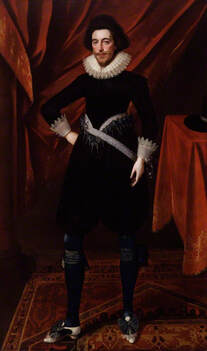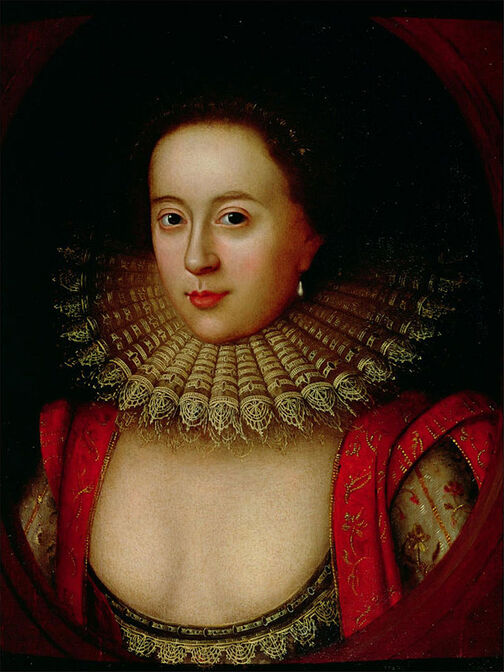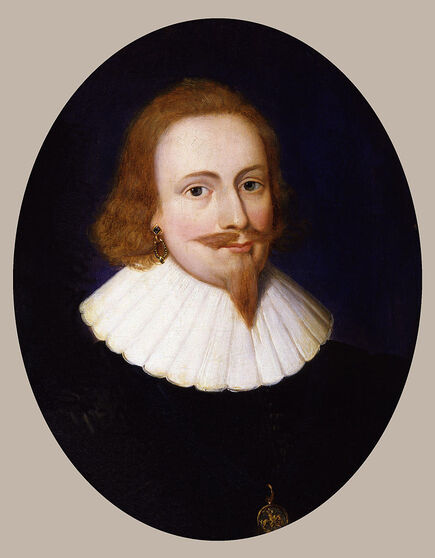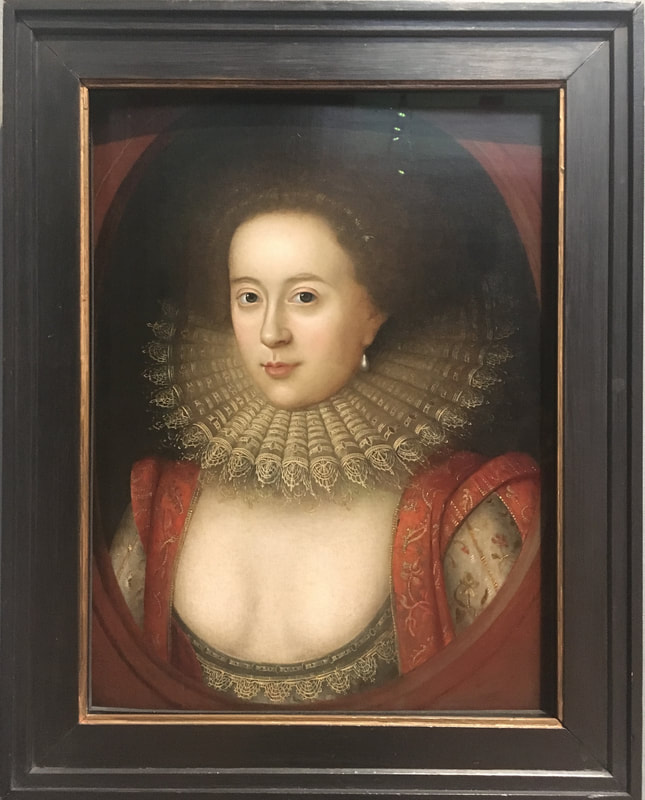 Jon Sleigh is an arts educator and learning curator. Recent working includes three years with the Arts Council Collection National Partners Program based at Birmingham Museums Trust. Jon now works across the country with diverse galleries / collections and writes for national publications on art history and theory. E: [email protected] T: jon_sleigh W: https://jonsleighfreelance.wixsite.com/about Its 1632. One of the most beautiful and controversial figures of the age lies dying of breast and uterine cancer. Local minister Arthur Wilson records the deathbed scene – Frances Carr, Countess of Somerset was “ killed by a disease of the below parts” and “died in “very great extremity….that part of her body which had been the receptacle of most her sin grown rotten (though she never had but one child) the ligaments falling, it fell down and was cut away in flakes, with a most nauseous and putrid savour which, to argument, she would roll herself in her own ordure in her bed, took delight in it”. (1) The horrific relish Wilson takes in describing an agonising death is truly shocking. You can almost hear the bile in his voice as he labours not only on her suffering, but that she found sexual pleasure in her pain. How did her contemporaries find it so easy to not only dehumanise her, but to ascribe extreme sexual pleasure to even the act of dying? Let’s meet Frances and unwrap the patriarchy and sex shaming around her life and times. Who was this “filthy woman…lewd and malicious”? (2) Frances was born into the powerful aristocracy of the Howard family. Raised in court intrigue, amid power-broking politics in which you lived or died, the contemporary chronicles reveal the emergence of a very contemporary woman. She was confident, privileged, literate and had the ability to exercise a voice. Her journey to adulthood also coincided with the reign of king James VI and I, and the perceived debauchery of his court. Queen Elizabeth I died in 1603 when Frances was 13, and with her died the matriarchal cult of the virgin. Young men no longer played courtly games of love with a queen in her late 60s, and the sexual tone of court life changed. Gone is the veneration of the virgin and the politics of power vs sexual denial. James I sees an era of financial and sexual excess, pilloried by a later generation of puritans. Bodices on women reached ever lower, to where it became fashionable for court women to appear bare breasted, including exposure down to the areola. Skirts bellowed outward under drum farthingales, emphasised by unnaturally small corseted waistlines – the woman’s body at once enticing yet hard to reach, trapped in a literal cage of wealth. Movement and momentum are severely restricted, women become gilded objects. We see this in the most famous portrait of Frances by William Larkin in the 1610’s. Pursed red lips, heavy cosmetics (a dangerous combination of mercury and lead) and sensual eyes are framed by a sharp yellow ruff. Her bodice plunges downwards as she smiles back at us, directly making eye contact. Art fossilises a moment in time, aristocratic confidence meeting the sexualised fashion of an era. King James himself in contrast to Queen Elizabeth expressed his sexuality publicly through marriage and five legitimate children. Privately, James also enjoyed both romantic and sexual relations with men. He was queer / bisexual to modern interpretation, but James would never have considered himself in these terms as that framework of understanding did not yet exist – sexual licence was a religious and social deviation - a choice made, symptomatic of an evil nature. Puritanism was sharply on the rise in Britain, and within a generation Oliver Cromwell rules and has banned Christmas.  Robert Devereux, 3rd Earl of Essex Robert Devereux, 3rd Earl of Essex “Almost all men spoke of the looseness of her carriage” – anon chronicler (3) At aged 14, Frances has an arranged marriage to the 13-year-old Robert Devereaux, 3rd Earl of Essex. She is framed from the outset in the midst of adult sexual politics, her reputation merging and disappearing into that of the Jacobean court. Arthur Wilson described her thus - “the court was her nest, her father being lord chamberlain, and she was hatched up by her mother whom the sour breath of that age (how justly I know not) had already tainted.” (4). The married couple were kept apart for five years as pregnancy was considered unhealthy for her age. During this time, it is rumoured Frances becomes the lover of Prince Henry Stuart, eldest son of James I. Her beauty was “of the greatest magnitude on the horizon” (5) When Robert returned the marriage proves to be a dynastic triumph, and a personal disaster. Robert is accused of preferring the company of his male friends, and that Frances was sexually uncooperative. In 1613 Essex reports, “when he was willing to have carnal knowledge of her body, she showed herself ready thereof…. some other times she refused it.” (6) A woman raised with confidence and away from her husband’s control echos through these words. Frances petitions for divorce on grounds that the marriage was never consummated and citing impotence in her husband – a powerful step and one that further compounding her association with sexuality. Frances was examined by a group of midwives who found her hymen to be intact, although many suspected the girl being examined was not Frances as she has been veiled throughout 'for modesty.' Frances then quickly moved to marry Robert Carr, Earl of Somerset. Popularly acknowledged as the lover of James I – Carr was similarly demonised as both sexual and powerful, a queer abnormality. At every point in her life – her fashions, her family, her marriages, Frances is framed to us as being highly sexed. “Her beauty caused devastation in the hopes, hearts, estates and understandings” (7) Frances' downfall came with the murder of Sir Thomas Ovebury, chief adviser to her husband. He despised Frances and worked to block her marriage to Carr. Frances in turn saw him as a threat to her politically and to her relationship with her husband. In his efforts to prevent the marriage, Thomas Ovebury offended Carr’s lover king James and was imprisoned in the tower, where he died. It was later revealed that he had been poisoned and suspicion fell on Frances and her new husband. Both were arrested and thrown in the tower. Sensationally, Frances admitted plotting to poison him with her servants' help, but her husband never admitted his involvement. The Countess no longer enjoys the political protection of the king, as he moved to damage limitation. Evidence supports that almost certainly she was instrumental in the death of Ovebury, if not in deed then at least in intention. The Frances and Robert were found guilty and sentenced to death, but were pardoned and kept in custody. The Somersets were ruined. Although they had escaped execution they remained imprisoned in the tower of London until 1622. Upon their release, they found themselves ostracised from society. Her reputation was sealed as not only debauched, but also as evil. But, let’s separate the two and try to see the patriarchy at play. Even before the murder she was condemned as promiscuous. Contemporary chronicler Simon D’Ewes wrote “by this example, as in many others we may see plainly that the conscience being once emasculated and cauterised by lust and whoredom, is then prepared and fitted for the commission of witchcraft, murder or any other villainy.” (8). And of course, if you’re a whore, murder is sure to follow.
As a contemporary arts educator, I would argue we must see Frances the murderer as separate from the demonisation of Frances the women in control of her own sexuality in 17th century Britain. To be part of a political assassination should not be synonymous with being an empowered woman. For me, Frances clearly committed an evil act in killing – yet her contemporaries and indeed history reads this as being the result of her gender and sexuality. Her crime is a vehicle for puritan historians in the 17th century to demonise other women for generations to come. Add to this her husband's sexuality, and enough ammunition is there to destroy not just Frances but to construct an archetype of the lustful, wicked woman that would then be used to punish others. Did her love of contemporary fashion make her kill? Did divorcing a husband she did not want to have sex with make her a killer? Did she murder because she’s a woman? Or did lust drive her to it? No. The act of murder damns her, not her gender or sexuality. Patriarchal faith and political histories have the power to ignore this. Contemporary male murderers were not referred to as “whores”. We must not defend Frances on the charge of murder, but its vial to see her clothes, privilege and sex life in a different light, interlaced with her story but not the de-facto motive. Her contemporaries enjoyed the same pleasures but were not murders. Through this historical filter, later readers across the centuries would have been primed to believe someone capable of murder would indeed enjoy sexually the act of dying in pain – why not? With no feminist counterpoint puritans literally wrote the book. As I consider this historical woman, I’m deeply conflicted. She is at both repellent and fascinating. She cannot be defended, yet she absolutely needs to be understood in the context of her time and gender. Frances offers a valuable light on the expectations of women through history, and the inherited narrative we grow up with on women that’s mostly presented to us through men. I recently stood before her portrait at the National Portrait Gallery by Larkin and pondered this. The murder jars with the glamour of her life at court, the powerful woman vies with the dying record of a woman in agony. Is her smile one of assured sexuality or sly and cunning? Try being with the artwork yourself and see how you feel. It’s a moment both ambiguous, uncomfortable and nuanced.
0 Comments
Leave a Reply. |
Sex History ContentsIf you would like to submit an article, please fill out a submission on the Contact page Archives
September 2020
|



 RSS Feed
RSS Feed